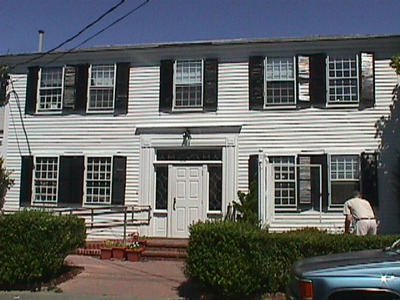460 Commercial St
Historic District Survey information for 460 Commercial St | |
Architectural Description: 460 Commercial St. is a 2-story, 5-bay, Georgian-style dwelling converted to institutional use; hipped roof is sheathed in asphalt shingles; exterior is clad in clapboard siding on the front facade with wood shingles on the secondary facades with wood trim; building sits on a brick foundation; fenestration includes single 12/12 DHS windows with lintels and storm windows; ; primary entrance in center bay is accessed by a panel replacement set in a large door surround with entablature and pilasters, and leaded glass sidelights and transom; brick steps and side brick wheelchair ramp to front door; right side facade has entry door opening cut into side; recessed concrete block addition on side facade; shed-roof addition near rear with central entry and 6/6 DHS; currently (2004) undergoing expansion of concrete block addition. |
|
Historical Narrative: This was one of the great Cook family houses. Because the reading of the 1858 Walling map is difficult and the numbers of the 1886 residential directory have been changed in recent times, it is not possible to determine with complete accuracy who this house originally belonged to; however, it was definitely a member of the Cook family. The closest authentication is from the 1880 map which gives its ownership to D.C. Cook. George Bryant's history of the properties at 465, 467 and 469 are further authentication of the family history here.
The Art Association bought this property in 1919 and Ross Moffett's account of it is as follows: There seems to have been an early realization that the Association would eventually need exhibition quarters of its own, and in 1919 we find the organization buying for $2,000 what was known as the Bangs property, and in 1920 purchasing for $3,000 the adjoining house on the east. The latter, with remodeling, would become the present large gallery while the Banks house, between the present building and Bangs Street would be torn down.
Since that time, the Art Association has been a continuous active artist's association and is the second oldest in the country (I believe the one at Old Lime, CT is the oldest). The prestige of the Provincetown art community is totally reflected by this organization, and every major American painter and most of the lesser artist have exhibited at one time in its galleries. Its importance as a historic art center is inestimable, and therefore it should qualify for Landmark designation. |
|
Bibliography and/or References: Bryant, George, Unpublished Text, History of Bryant's Market and environs, 1977.
Vorse, Mary Heaton. Time and the Town. Provincetown, 1942.
Moffett, Ross. "Art in Narrow Streets. Kendal Press, 1964. |
|
Text |
|
Commercial Street (Provincetown, Mass.), Dwellings, and Historic Districts--Massachusetts--Provincetown |
|
Comments (0)
NOTICE: It appears you do not have Javascript enabled in your Web browser. To access some of the features on the site (including email links) you must enable Javascript and refresh the page.



There are no comments for this archive.